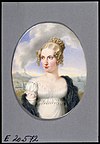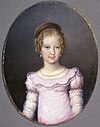Francis II of the Holy Roman Empire and I of Austria
Francis II of the Holy Roman Empire (Florence, Tuscany, February 12, 1768-Vienna, Austrian Empire, March 2, 1835) was the last Holy Roman Emperor, as Francis II (1792-1806) and the first of Austria, as Francis I (1804-1835).
In 1804, he became Emperor of Austria, a title he held until his death in 1835. For two years (1804-1806), Francis combined two imperial dignities, Austrian and German — for which he was nicknamed Doppelkaiser ("Double Emperor")—, being the first and only sovereign to do so. In 1806, as a consequence of his defeat at the Battle of Austerlitz, he suppressed the Holy Roman Empire, leading to his disappearance.
Francis continued to oppose France during the Napoleonic Wars and suffered several more defeats after Austerlitz. The proxy marriage of his daughter Maria Luisa to Napoleon in 1810 was his most severe personal defeat. After Napoleon's abdication following the War of the Sixth Coalition, Austria participated as a leading member of the Holy Alliance in the Congress of Vienna—later led by Francis' chancellor Klemens von Metternich—which culminated in a new map of Europe and in the restoration of Francis' former domains (except the Holy Roman Empire).
Early Years
Francis was born in Florence, Tuscany, the eldest son of Leopold II (1747-1792) and the Infanta Maria Luisa of Spain (1745-1792). On his father's side he was the grandson of Empress Maria Theresa I of Austria and Emperor Francis I (from whom he received his name), while on his mother's side he was the grandson of King Charles III of Spain and Maria Amalia of Saxony. He was also a nephew of Queen Marie Antoinette of Austria, Emperor Joseph II, and King Charles IV of Spain. He had a happy childhood surrounded by his many siblings.
Knowing that he might become emperor since his uncle Joseph II was childless, in 1784 the young archduke was sent to the imperial court in Vienna to educate him and prepare him for his future role. Emperor Joseph II took charge of his education and progress. The new regime was in stark contrast to the lenient discipline of his father's Florentine court. The emperor wrote that Francis was "slow in growth" and he was "no more and no less than the son of a spoiled mother".
After the death of Joseph II in 1790, his father became emperor. However, his health gradually declined in early 1792 and he died on March 1 of that year at the age of 44. Francis, aged 24, succeeded him as emperor.
Reign
During his tenure his right-hand man was Metternich, conductor of the Congress of Vienna, whose relevant management returned the territories that had been occupied to the Austrian crown. Francisco, who was a convinced reactionary, established his power over measures of police repression and censorship, to ward off the threat of liberalism. In this task he had the invaluable help of Metternich, with whom he came to fully identify in the final years of the reign.
Clashes with France
After the fall of King Louis XVI of France, the Empire participated prominently in the successive coalitions against revolutionary France, which resulted in territorial losses for the Emperor. Later it was immersed with the rest of the continent in the conflict against Napoleón Bonaparte. He participated in the Congress of Vienna and was associated with the Holy Alliance.
In 1804 Francis I had taken the title of Emperor of Austria and on August 6, 1806, he had decreed the disappearance of the Holy Roman Empire, which had ruled since 1792, after Napoleon's ultimatum. The Austrian Empire was the result of the accumulation of a series of territorial possessions among which, apart from the Austrian territories themselves, one had to add the kingdoms of Hungary, Bohemia and Dalmatia, the Italian provinces of Lombardy and Venice, the area of Galicia and Krakow and the duchies of Salzburg and Bucovina.
After the celebration of the marriage between his daughter, Marie Louise of Habsburg-Lorraine, with Napoleon in 1810, the Austrian Empire sided with France for a period, but finally, in 1813, Francis I had to ally with Prussia and Russia to face the alleged hegemony of Napoleon Bonaparte over Europe, an alliance that was maintained until the final defeat of the French emperor at the Battle of Waterloo in June 1815.
Marriages
Francisco was married four times:
- On 6 January 1788 he first married the Duchess Isabel Guillermina of Württemberg (1767-1790), daughter of Federico II Eugenio of Wurtemberg and Federica of Brandenburg-Schwedt. The marriage turned out to be extremely happy and two years later, at the beginning of 1790, the Archdukes expected the birth of their first child. In February of that year, the princess entered labor. Lighting was long and difficult, so they had to use forceps, so the baby's brain was seriously damaged. Finally, Isabel was overwhelmed by an uncontrollable hemorrhage that ended her life. Her only daughter, the archduchess Luisa Isabel Francisca, died a year after her birth.
- Seven months after the death of his first wife, Francis espoused her cousin, Princess María Teresa de las Dos Sicilias (1772-1807), daughter of her uncles Fernando I de las Dos Sicilias and Maria Carolina of Austria. Francis had developed an inclination to melancholy, he was shy, serious and closed, while Maria Teresa was a cheerful, dominant and strong temperament person. However, despite their different personalities, marriage was also described as happy. Throughout seventeen years of marriage, the couple brought to the world a total of twelve children. María Teresa died on 13 April 1807 in Vienna, due to complications during the birth of her youngest daughter Amelia, at the age of 34.
- In January 1808, Francis married another cousin, Princess Maria Luisa of Austria-Este (1787-1816), with whom he had no children.
- At the death of Maria Luisa in 1816, Francis married Princess Carolina Augusta de Baviera (1792-1873). This marriage had no children.
On his death, on March 2, 1835 in Vienna, he was succeeded by his son Ferdinand I.
Offspring
Ancestors
| Francis I Ancestors of Austria | ||||||||||||||||||||||||||||||||||||||||||||||||||||||||||||||||||||||||||||||||||||||||||||||||||||||||||||||||||||||||||||||||||||||||||||||||||||||||||||||||||||||||||||||||||||||||||||||||||||||||||||||||||||||||||||||||||||||||||||||||||||||||||||||||||||||||||||||||||||||||||||||||||||||||||||||||||||||||||||||||||||||||||||||||||||||||||||||||||||||||||||||||||||||||||||||||||||||||||||||||||||||||||||||||||||||||||||||||||||||||||||||||||||||||||||||||||||||||||||||||||||||||||||||||||||||||||||||||||
|---|---|---|---|---|---|---|---|---|---|---|---|---|---|---|---|---|---|---|---|---|---|---|---|---|---|---|---|---|---|---|---|---|---|---|---|---|---|---|---|---|---|---|---|---|---|---|---|---|---|---|---|---|---|---|---|---|---|---|---|---|---|---|---|---|---|---|---|---|---|---|---|---|---|---|---|---|---|---|---|---|---|---|---|---|---|---|---|---|---|---|---|---|---|---|---|---|---|---|---|---|---|---|---|---|---|---|---|---|---|---|---|---|---|---|---|---|---|---|---|---|---|---|---|---|---|---|---|---|---|---|---|---|---|---|---|---|---|---|---|---|---|---|---|---|---|---|---|---|---|---|---|---|---|---|---|---|---|---|---|---|---|---|---|---|---|---|---|---|---|---|---|---|---|---|---|---|---|---|---|---|---|---|---|---|---|---|---|---|---|---|---|---|---|---|---|---|---|---|---|---|---|---|---|---|---|---|---|---|---|---|---|---|---|---|---|---|---|---|---|---|---|---|---|---|---|---|---|---|---|---|---|---|---|---|---|---|---|---|---|---|---|---|---|---|---|---|---|---|---|---|---|---|---|---|---|---|---|---|---|---|---|---|---|---|---|---|---|---|---|---|---|---|---|---|---|---|---|---|---|---|---|---|---|---|---|---|---|---|---|---|---|---|---|---|---|---|---|---|---|---|---|---|---|---|---|---|---|---|---|---|---|---|---|---|---|---|---|---|---|---|---|---|---|---|---|---|---|---|---|---|---|---|---|---|---|---|---|---|---|---|---|---|---|---|---|---|---|---|---|---|---|---|---|---|---|---|---|---|---|---|---|---|---|---|---|---|---|---|---|---|---|---|---|---|---|---|---|---|---|---|---|---|---|---|---|---|---|---|---|---|---|---|---|---|---|---|---|---|---|---|---|---|---|---|---|---|---|---|---|---|---|---|---|---|---|---|---|---|---|---|---|---|---|---|---|---|---|---|---|---|---|---|---|---|---|---|---|---|---|---|---|---|---|---|---|---|---|---|---|---|---|---|---|---|---|---|---|---|---|---|---|---|---|---|---|---|---|---|---|---|---|---|---|---|---|---|---|---|---|---|---|---|---|---|---|---|---|---|---|---|---|---|---|---|---|---|---|---|---|---|---|---|---|---|---|---|---|---|---|---|---|---|---|---|
| ||||||||||||||||||||||||||||||||||||||||||||||||||||||||||||||||||||||||||||||||||||||||||||||||||||||||||||||||||||||||||||||||||||||||||||||||||||||||||||||||||||||||||||||||||||||||||||||||||||||||||||||||||||||||||||||||||||||||||||||||||||||||||||||||||||||||||||||||||||||||||||||||||||||||||||||||||||||||||||||||||||||||||||||||||||||||||||||||||||||||||||||||||||||||||||||||||||||||||||||||||||||||||||||||||||||||||||||||||||||||||||||||||||||||||||||||||||||||||||||||||||||||||||||||||||||||||||||||||
Titles, orders and jobs
Titles
- 12 February 1768-20 February 1790: His Imperial Highness the Archduke Francisco (Franz) of Austria.
- 20 February 1790-1 March 1792: Your Imperial and Royal Highness the Archduke Francis (Franz), Imperial Prince of Austria and Royal Prince of Hungary.
- 1 March 1792-11 August 1804: His Imperial and Royal Majesty the Holy Roman Emperor, King of Hungary and Bohemia, etc.
- 11 August 1804-6 August 1806: His Imperial and Royal Majesty the Holy Roman Emperor, Emperor of Austria, King of Hungary and Bohemia, etc.
- 6 August 1806-2 March 1836: His Imperial and Royal Majesty the Emperor of Austria, King of Hungary and Bohemia, etc.
From 1806 until his death, the full title was:
I'm sorry.
In Spanish:
Hails, Hails, and Hails,
Orders
 Monarchy Habsburg:
Monarchy Habsburg:
- Knight of the Golden Toy, 1768
- Grand Cross of the Military Order of Mary Teresa, 1790
- Founder and Grand Master of the Imperial Order of Leopoldo, 8 January 1808
- Founder and Grand Master of the Imperial Order of the Iron Crown, 1815
- France:
 Kingdom of Bavaria: Knight of St. Huberto, 1813
Kingdom of Bavaria: Knight of St. Huberto, 1813 Sweden: Great Cross of the Sword, 1st Class, 20 February 1814
Sweden: Great Cross of the Sword, 1st Class, 20 February 1814 United Kingdom: Knight of the Road, 9 June 1814
United Kingdom: Knight of the Road, 9 June 1814 Denmark: Elephant Knight, 12 November 1814
Denmark: Elephant Knight, 12 November 1814 Kingdom of Portugal: Grand Cross of the Band of the Three Orders, 1818
Kingdom of Portugal: Grand Cross of the Band of the Three Orders, 1818 Two Sicilies:
Two Sicilies:
- Knight of San Jenaro, 1821
- Gran Cruz de San Fernando y del Mérito
 Kingdom of Sardinia: Knight of the Annunciation, 3 January 1824
Kingdom of Sardinia: Knight of the Annunciation, 3 January 1824 Russian Empire:
Russian Empire:
- Knight of Saint Andrew, 13 March 1826
- Knight of Saint Alexander Nevski, 13 March 1826
 Empire of Brazil:
Empire of Brazil:
- Grand Cross of the Order of Peter I, 1827
- Great Cross of the South Cross, 1830
 Grand Duchy of Baden:
Grand Duchy of Baden:
- Grand Cross of the Order of Fidelity, 1830
- Grand Cross of the Lion of Zähringen, 1830
 Grand Duchy of Tuscany: Gran Cruz de San José
Grand Duchy of Tuscany: Gran Cruz de San José
Military Jobs
- Colonel owner (Inhaber) of the Imperial and Royal Infantry Regiment n.o 1 (Moravo) of the Imperial and Royal Army.
- Colonel owner (Inhaber) of the Imperial and Royal Army Hunters Regiment.
- Colonel owner (Inhaber) of the Imperial and Royal Regiment of Coraceros n.o. 1 of the Imperial and Royal Army.
- Colonel proprietor (Inhaber) of the Imperial and Royal Cavalry Regiment No. 1 of the Imperial and Royal Army.
- Colonel (Inhaber) of the Imperial and Royal Regiment of Húsares n.o. 1 of the Imperial and Royal Army.
- Colonel owner (Inhaber) of the Imperial and Royal Regiment of Ulanos n.o. 4 of the Imperial and Royal Army.









